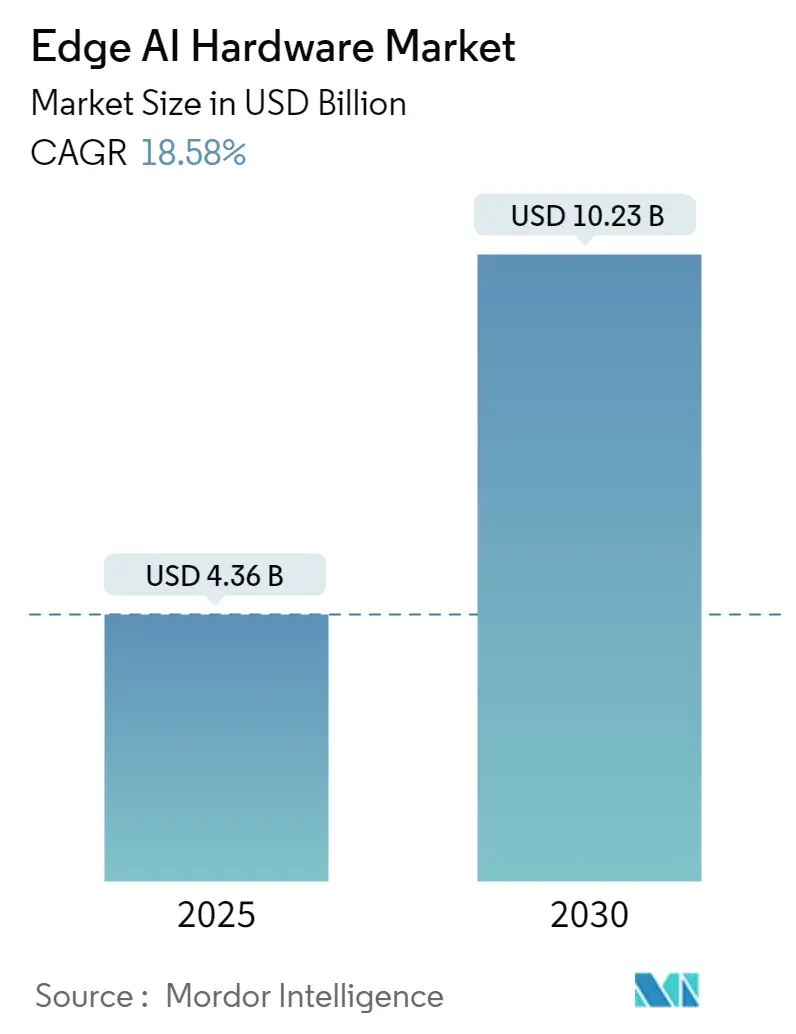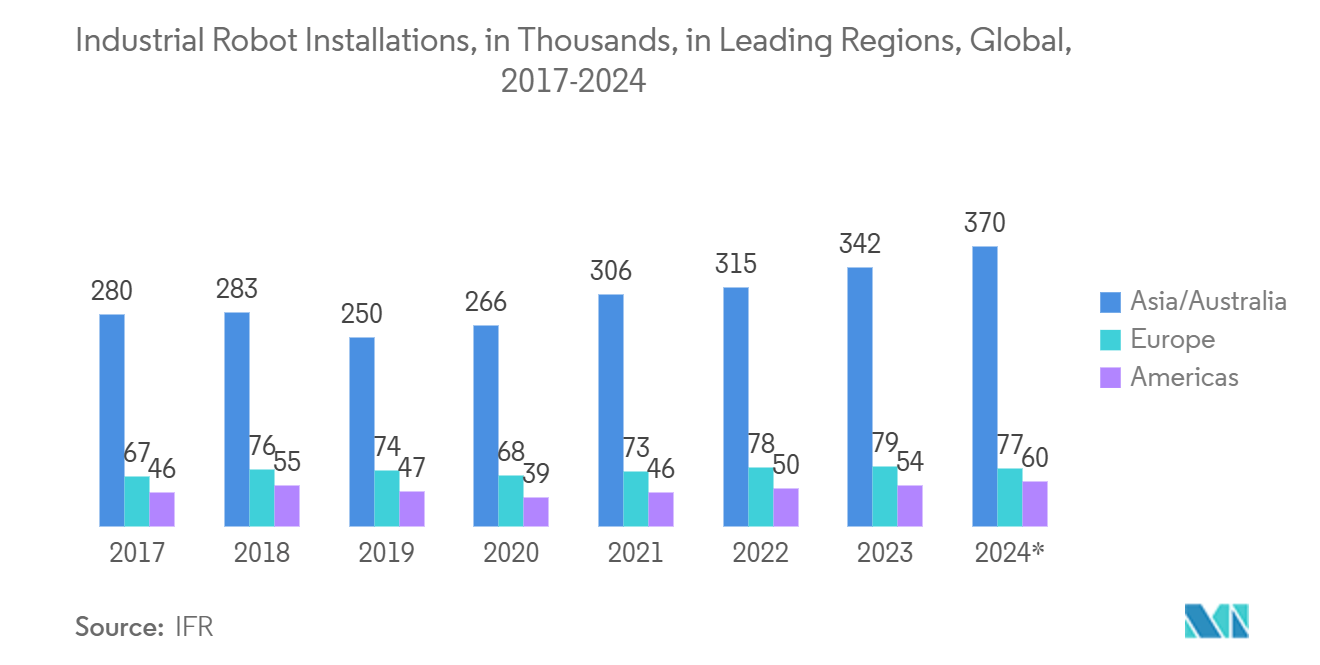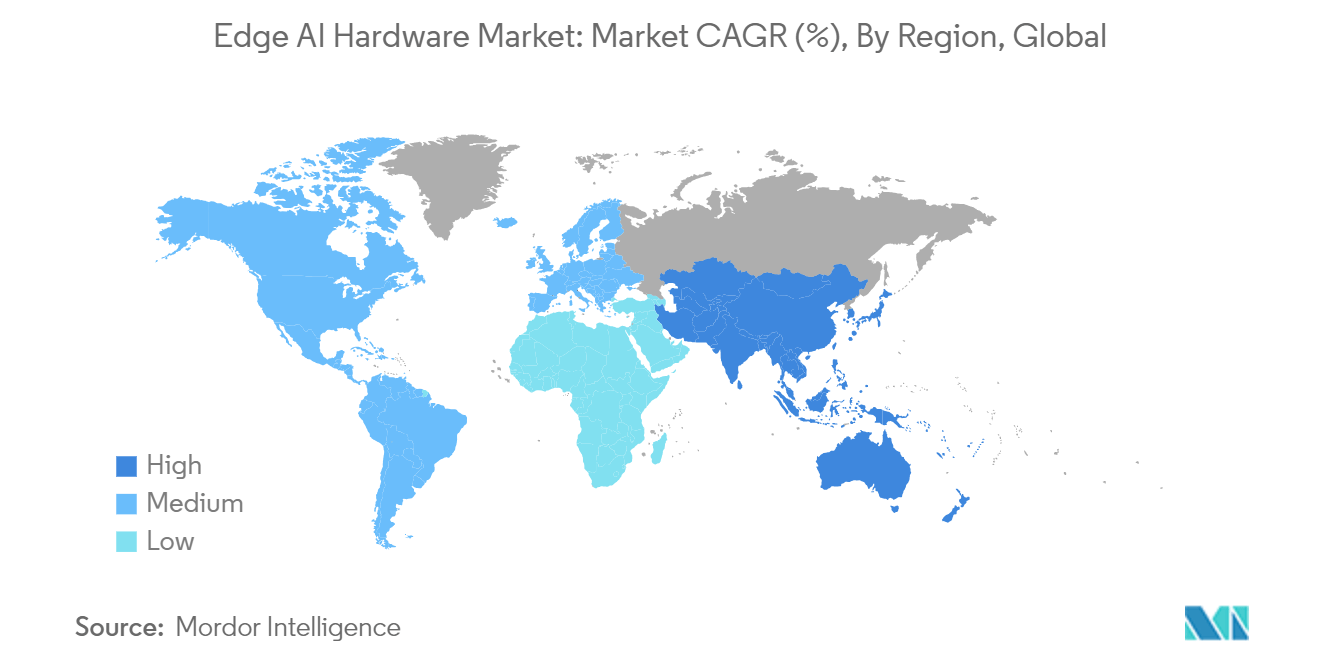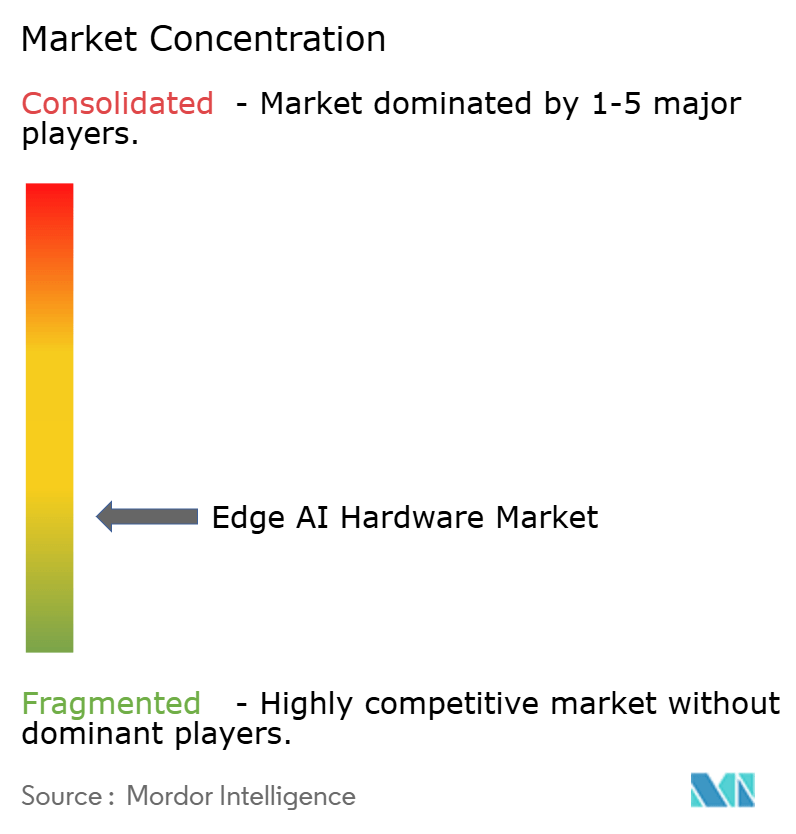Edge Artificial Intelligence (AI) Hardware Market Analysis
The Edge AI Hardware Market size is estimated at USD 4.36 billion in 2025, and is expected to reach USD 10.23 billion by 2030, at a CAGR of 18.58% during the forecast period (2025-2030).
- Driven by the quest for heightened realism in virtual reality (VR) environments, the demand for Edge AI hardware is witnessing a significant surge. VR environments necessitate ultra-low latency for a truly immersive experience; even a minor processing delay can disrupt the user's sense of presence. Edge AI hardware facilitates on-device processing, significantly reducing the data transfer between the device and the cloud. This ensures the real-time performance crucial for VR applications, including gaming, simulations, and training programs.
- Edge AI hardware is transforming the media and entertainment industry, primarily due to its capability for real-time, high-performance processing. This attribute is essential for creating immersive and tailored experiences. Leading media streaming platforms, such as Netflix, YouTube, and Amazon Prime Video, are increasingly leveraging Edge AI hardware to enhance real-time content delivery. By processing data closer to the end-users, Edge AI effectively reduces latency, guaranteeing smooth video streaming and an enhanced viewing experience.
- Beyond the realm of streaming, Edge AI hardware is instrumental in video editing and broadcasting. It boasts capabilities like upscaling resolutions, enhancing frame rates, and applying filters or effects in real-time. For example, AI algorithms can elevate a standard video directly to 4K or even 8K on edge devices, boosting viewing quality without relying on the cloud. Furthermore, AI-driven video compression on edge devices optimizes bandwidth usage, a critical factor for live streaming where it's essential to maintain video quality while reducing data loads.
- However, the Edge AI hardware market grapples with challenges, primarily due to the hefty upfront investments in both hardware and software. The foundation of Edge AI hardware comprises specialized chips, GPUs (such as Nvidia's Jetson platform), Tensor Processing Units (TPUs), and other high-performance processors. While these components are vital for real-time data processing and AI inference, their high costs pose a barrier to adoption, particularly for smaller enterprises and industries with tighter budgets.
- Post the COVID-19 pandemic, trends like the demand for communication devices, digitalization, the rise of smart buildings, ADAS-equipped vehicles, and the principles of Industry 4.0 have spurred the growth of smart electronics and communication devices, subsequently driving the market expansion.
Edge Artificial Intelligence (AI) Hardware Market Trends
Robots Device Segment is Expected to Hold Significant Market Share
- Artificial intelligence (AI) and edge computing are rapidly reshaping the landscape of robotics, ushering in an era of smarter and more autonomous machines. Edge computing efficiently processes vast data volumes, tackling traditional challenges in robotics, such as latency and bandwidth issues. Concurrently, AI equips robots to learn from their experiences and make informed decisions, leading to machines that are both intelligent and adaptable. This article explores the profound influence of these technologies on the future of robotics and automation.
- Edge-AI enables robots to make real-time decisions by processing environmental data on-site, allowing for swift adaptation to their surroundings. This edge processing, powered by AI, utilizes both machine learning and inference algorithms. Such responsiveness is vital in sectors like autonomous vehicles and manufacturing, where timely reactions to environmental changes are crucial.
- Moreover, edge AI boosts the accuracy of robotic decisions. By deploying AI algorithms on edge devices, robots enhance their decision-making precision. This heightened accuracy is paramount in industries like healthcare, where the stakes are high.
- Additionally, Edge-AI fortifies robotics with enhanced privacy and security. By storing data on edge devices, the risk of sensitive information being intercepted en route to centralized data centers or the cloud diminishes. This protection is essential for sectors like healthcare and finance, which handle personal data. With data processed on the edge, the transfer of sensitive information is significantly reduced. The cloud then acts as both a repository for this processed data and a control center for connected devices. This shift has led to a surge in demand for edge AI hardware, bridging the gap between software and robotics.
- In April 2024, Qualcomm launched its Edge AI RB3 Gen 2 Chip tailored for IoT and robotics, accompanied by a "Micro-Power" Wi-Fi SoC. These development kits aim to expedite the company's AI-accelerating chip's deployment, targeting not just robotics and IoT but also embedded applications and boasting a potential power draw reduction of up to 88%. Such investments, heavily leaning on Edge AI, are driving the robotics segment's growth in the market.
Asia Pacific to Register Major Growth
- The Asia Pacific region stands out as a dominant player in the consumer electronics market. Major countries, including India, China, and Korea, are ramping up local production through government initiatives and the presence of key industry players. This push is set to amplify the demand for consumer electronics. The market's expansion is further fueled by the direct integration of AI algorithms into edge devices, encompassing smartphones, IoT devices, and embedded systems. Additionally, with rising investments in the region, the appetite for these market technologies is poised for substantial growth.
- According to the China Academy of Information and Communications Technology (CAICT), China's mobile phone shipments in 2023 reached 289 million units, marking a 6.5% increase from the previous year. Shipments of 5G phones hit 240 million units, an 11.9% annual rise, making up 82.8% of the country's total mobile phone shipments. CAICT data also highlighted the introduction of 406 new domestic-brand phone models, a 5.5% increase from the prior year. December 2023 saw mobile phone shipments touch approximately 28.28 million units, reflecting a 1.5% year-on-year growth. These significant developments are poised to positively influence the market's growth.
- Moreover, according to Invest India, the electronics market in India is currently valued at USD 155 billion, with domestic production constituting 65% of this value. The accelerated adoption of electronic products is being driven by technological transitions, notably the rollout of 5G networks and the Internet of Things (IoT). Initiatives like 'Digital India' and 'Smart City' projects have heightened the demand for IoT in the electronics devices market, signaling the dawn of a new era for electronic products. Over the past six years, India has not only emerged as the world's second-largest mobile manufacturer but has also seen its domestic production of electronics more than double.
- The Asia Pacific region, historically a manufacturing powerhouse, is increasingly embracing the Internet of Things (IoT). Telenor IoT reports that in APAC, the synergy between established IoT frontrunners like South Korea, Japan, Australia, and China and emerging players such as India, Pakistan, Bangladesh, Indonesia, and Thailand is propelling the number of IoT devices from a recent tally of 14.5 billion to a projected 38.9 billion by 2030. With this anticipated surge in IoT, there's a parallel expectation for a significant uptick in demand for Edge AI hardware.
- Furthermore, the growing adoption of robots across multiple industries in the region is also expected to drive market opportunities. According to IFR, in 2023, Asia emerged as the dominant force in industrial robot adoption, representing 70% of all new installations. Notably, China stands out, contributing a significant 51% to the global tally, boasting 1,755,132 operational robots across its factories.
Edge Artificial Intelligence (AI) Hardware Industry Overview
The Edge AI Hardware market is dominated by major vendors that cover a significant share of the market studied, and they are intensely competing to gain a foothold in different regional markets. Owing to this, vendors are involved in several partnerships and alliances to gain market presence and technological capabilities. Some of the major players in the market are Intel Corporation, Huawei Technologies Co. Ltd, Nvidia Corporation, Advanced Micro Devices Inc., and Baidu Inc., among others.
The competitive strategy among the vendors is to gain a foothold in the market studied with innovation, and the capability of investing in R&D by major vendors is on the higher side, thus, intensifying the competition in the market studied.
Access to the distribution channel, existing business relations, and better supply chain knowledge, along with the self-owned platform, give the established tech giants a market advantage over the new competitors. Overall, the degree of competitive rivalry in the market studied is moderately high and expected to remain the same over the forecast period.
Edge Artificial Intelligence (AI) Hardware Market Leaders
-
Intel Corporation
-
Huawei Technologies Co. Ltd
-
Nvidia Corporation
-
Advanced Micro Devices Inc.
-
Baidu Inc.
- *Disclaimer: Major Players sorted in no particular order
Edge Artificial Intelligence (AI) Hardware Market News
- July 2024: VIA Technologies has teamed up with Rutronik to expand the reach of its advanced IoT, edge AI, and computer vision technologies, focusing on clientele in the industrial, retail, and commercial sectors. This collaboration is strategically timed, capitalizing on the rising demand for edge computing in sectors seeking real-time data processing and lower latencies in their IoT applications. VIA's intelligent edge solutions, featuring MediaTek Genio processors, present a versatile platform tailored to various applications.
- July 2024: TRUMPF, one of the leading laser technology companies, and SiMa.ai, a software-centric firm specializing in embedded edge machine learning systems, have joined forces in a strategic partnership. The companies aim to infuse TRUMPF's laser systems with advanced artificial intelligence (AI) capabilities. The collaboration focuses on a range of applications, from welding and cutting to marking, and extends to TRUMPF's powder metal 3D printers.
Edge Artificial Intelligence (AI) Hardware Industry Segmentation
The scope for the edge AI hardware market primarily includes processors, sensors, and cameras that address the need for cognitive computing needs. These devices are used to power and process various AI-based devices. Multiple types of processors used in edge AI devices include semiconductor products such as central processing units (CPU), graphic processing units (GPU), field-programmable gate arrays (FPGA), and application-specific integrated circuits (ASICs).
The edge AI hardware market is segmented by processor (CPU, GPU, FPGA, ASIC), by device (smartphones, cameras, robots, wearables, smart speakers), by end-user industry (government, consumer electronics, real estate, automotive, transportation, healthcare, manufacturing, others), and by geography (North America, Europe, Asia Pacific, Latin America, Middle East and Africa). The market sizes and forecasts are provided in terms of value in USD for all the above segments.
| By Processor | CPU |
| GPU | |
| FPGA | |
| ASICs | |
| By Device | Smartphones |
| Cameras | |
| Robots | |
| Wearables | |
| Smart Speaker | |
| Other Devices | |
| By End-User Industry | Government |
| Real Estate | |
| Consumer Electronics | |
| Automotive | |
| Transportation | |
| Healthcare | |
| Manufacturing | |
| Others | |
| By Geography*** | North America |
| Europe | |
| Asia | |
| Australia and New Zealand | |
| Latin America | |
| Middle East and Africa |
Edge Artificial Intelligence (AI) Hardware Market Research FAQs
How big is the Edge AI Hardware Market?
The Edge AI Hardware Market size is expected to reach USD 4.36 billion in 2025 and grow at a CAGR of 18.58% to reach USD 10.23 billion by 2030.
What is the current Edge AI Hardware Market size?
In 2025, the Edge AI Hardware Market size is expected to reach USD 4.36 billion.
Who are the key players in Edge AI Hardware Market?
Intel Corporation, Huawei Technologies Co. Ltd, Nvidia Corporation, Advanced Micro Devices Inc. and Baidu Inc. are the major companies operating in the Edge AI Hardware Market.
Which is the fastest growing region in Edge AI Hardware Market?
Asia Pacific is estimated to grow at the highest CAGR over the forecast period (2025-2030).
Which region has the biggest share in Edge AI Hardware Market?
In 2025, the Asia Pacific accounts for the largest market share in Edge AI Hardware Market.
What years does this Edge AI Hardware Market cover, and what was the market size in 2024?
In 2024, the Edge AI Hardware Market size was estimated at USD 3.55 billion. The report covers the Edge AI Hardware Market historical market size for years: 2019, 2020, 2021, 2022, 2023 and 2024. The report also forecasts the Edge AI Hardware Market size for years: 2025, 2026, 2027, 2028, 2029 and 2030.
Our Best Selling Reports
Edge AI Hardware Industry Report
The global edge artificial intelligence hardware market is witnessing substantial growth, propelled by the increasing adoption of edge AI applications in sectors like healthcare, IT & telecom, consumer electronics, and automotive. This growth is driven by the integration of AI with edge computing, enabling real-time data processing and reduced latency, thus boosting IoT device efficiency. Key growth areas include smart healthcare, intelligent transportation, and smart factories. The AI hardware segment leads the market, spurred by the demand for IoT-based solutions and the expansion of 5G networks, which enhance edge connectivity and processing capabilities. North America holds a significant market share due to its advanced technological infrastructure and swift adoption of AI technologies. Meanwhile, the Asia-Pacific region is set to experience notable growth, fueled by the rising smartphone penetration and growth in industrial and automotive sectors adopting edge AI solutions. Leading edge AI companies are innovating and collaborating to expand their market presence. For comprehensive insights on edge AI market size and AI hardware market size, including a market forecast and historical data, download a free report PDF from Mordor Intelligence™ Industry Reports.

-Hardware-Market-ML.webp)





